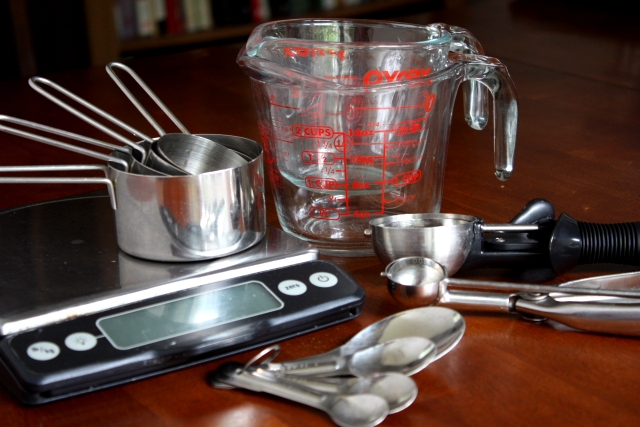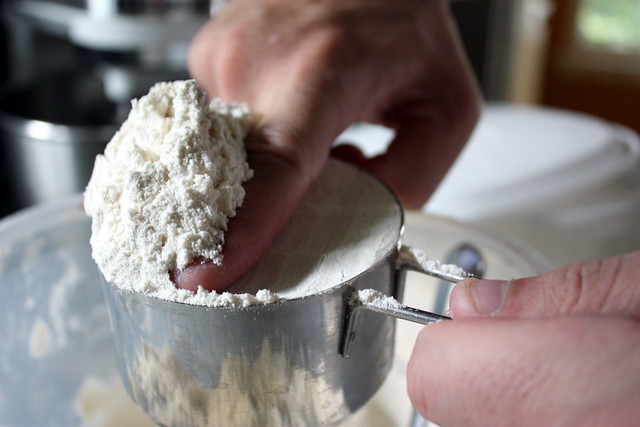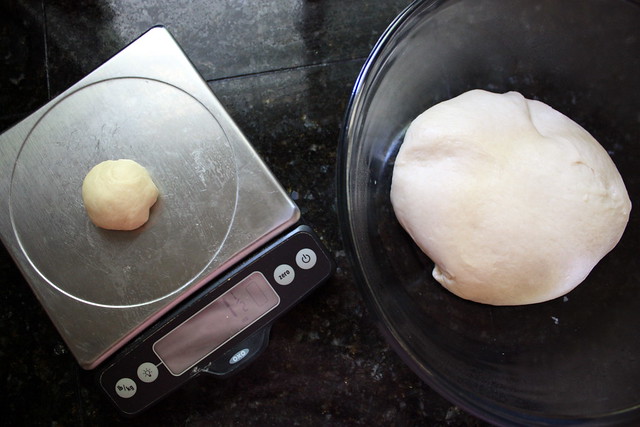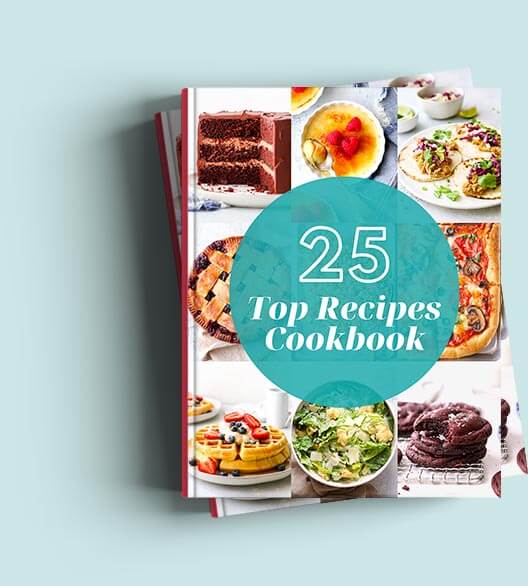Baking Essentials: Weight vs. Volume
Welcome to my first Baking Essentials post! I’m taking on a new project to learn more about baking, and I’m bringing you along for the ride. Hopefully we’ll all come out on the other side better bakers.
Before I dig into ingredients and baking methods, I wanted to explain that going forward I’ll be changing the way I provide recipes. I’ll now include weight measurements in addition to volume (cups, teaspoons, etc.) in my list of ingredients.
My reasoning for this is that the first lesson in baking is accuracy. It’s a lesson I learned in culinary school, but I got lazy. Too much or too little of a single ingredient can completely change the final product. And measuring by volume increases the chance of inaccuracy. For one thing, many ingredients, such as flour, are compressible. So when you dig your measuring cup into a bag of flour, it’s likely you’re getting more flour in that cup than you want. It’s best to aerate your flour by sifting it before you measure it (see how I measure flour by volume), or take the guessing work out and use a scale.
Another reason to measure by weight is that the size of the objects you’re measuring affects the volume. Whole nuts, roughly chopped nuts, and finely chopped nuts will fill your measuring cup differently. It’s almost impossible to get a consistent result that way. You’d be much better weighing them.
So, in the name of becoming a better baker I will now be weighing all of my ingredients. And because metric measurements are more universal and easier to work with, I’ll be weighing in grams and other metric units where applicable. Ounces and pounds can be hard to divide and multiply, and I’m not so good at math.
If you don’t already own a digital scale, I highly recommend you get one. Not only will they help you be more accurate with your ingredients, but they are very helpful in other ways. For example, most digital scales come with a “tare” function which allows you to zero out the scale. So you can place your mixing bowl on the scale, zero it out and then weigh each ingredient as you add it, zeroing it out after each one.
Anyone else up for the challenge of using weight instead of volume? It’s smarter, not as hard as you may think, and no measuring cups and spoons means less mess to clean up!
References:
“I’m Just Here for More Food” by Alton Brown
“On Baking” by Sarah Labensky, Eddy Van Damme, Priscilla Martel, and Klaus Tenbergen





For me this is going to be great! I have been weighing ingredients for about a year and my baking results have been doing much better. I never knew that I could zero out after each ingredient. Already something new. We shall be happy learning together. Thank you.
I love my scale too. It really is easier to bake that way if the recipe lists the measurements. I’ll look forward to the new recipes!
I have a scale but don’t use it for baking. I keep thinking I should. Thank you for the nudge. Looking forward to the recipes to come!
I keep saying that I’m going to start baking with weight when it’s listed, but I still don’t the majority of the time. I really should change that!!
I have the same scale as you and it is indispensable! I have slowly moved over to weighing ingredients, particularly when following recipes from some of my favorite baking books, and it really does make a difference. Great post, Annalise!
I need to take notes, because I am terrible at baking!
We have a scale, but I am lazy sometimes:) Great post!
I agree. Since owning a digital scale, my baking has improved and has been consistent over time. I’m slowly converting all my recipes over to ounces, although I’ve discovered grams are more accurate….
I needed this!!!! I’m a baking DUNCE! for real =)
I’ve been toying with getting a scale and using it, it seems like I don’t bake enough to justify it. But I am obsessed with baking recipes — ah, the irony! What brand do you have? It looks like OXO? Do you like it?
Yes, it is OXO (this one to be exact: http://amzn.to/oUY234) and I love it! It’s very simple but has everything I need in a digital scale. I also like that I can pull the piece with the screen and buttons out if I’m weighing something large.
I have had my scale a little over a year now and love it. However, with all the talk about how much better it is to weigh there are not many people listing the ingredients that way so for that I thank you!! I will be a regular visitor because of this. Could you provide information on converting ingredients to grams, is there a resource online that you use to find the weights of the individual ingredients?
Thank you. THANK you. THANK YOU! I’m new to baking from scratch and I’ve been getting a lot of fabulous recipes from Pinterest. Unfortunately, most of those recipes are from American bakers, and I’m from England. So I spend an awful lot of time converting cups to grams! My heart *soars* when I find a recipe in grams, and your post here was fantastic to read.
I’m now going to check out all your recipes!
All best wishes,
Penny
I’m so happy to hear you found this helpful. Thank you so much for the comment, Penny! Happy baking!
Is there a chart somewhere for the basic weights/cups
for the most common ingredients??
sugar, powdered sugar, brown sugar etc?
Hi Kristin! I like this chart: http://www.kingarthurflour.com/recipe/master-weight-chart.html.
Perfect! Thank you 🙂
I too, like cooking by weight and love my scale!
Its informative blog, thanks.
Hi, I have problem weighing small amount such as 1 gm salt. The digital weighing machine didn’t show any amt until it’s about 3 gm.